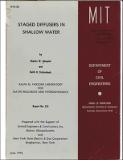Staged Diffusers in Shallow Water
Author(s)
Almquist, Charles W.; Stolzenbach, Keith D.
Download03199237.pdf (5.283Mb)
Metadata
Show full item recordAbstract
The discharge of waste heat from electric power plants into natural water bodies has the potential for adversely affecting the aquatic ecology of the receiving water. Because each discharge site has its own physical and biological characteristics, design and siting of such discharges to insure that potential impacts are within acceptable levels requires both the flexibility to tailor the discharge design to the site and the ability to predict the induced temperature rise over a broad range of spatial and temporal scales. In this study, the class of semi-infinite, shallow receiving water bodies (which includes large lakes and eastern coastal regions of the U.S.) is identified as being an important subset of potential sites for waste heat disposal. On the basis of previous investigations of heated discharges, one particular discharge design, the "staged" diffuser, is shown to be particularly suited to many water bodies of this class. The analysis of the near field temperature rise induced by the staged diffuser for quiescent conditions in a semi-infinite, shallow receiving water body is defined as the objective of the study. A theory describing performance of the staged diffuser under the defined conditions is developed by schematizing the diffuser as a continuous line source of momentum. The analysis proceeds from a set of integrated continuity and momentum equations, similar to those used in free turbulent jet analysis, but with the addition of a region with a continuous input of momentum. The theory requires the specification of similarity functions for lateral velocity and temperature profiles, and the values of the entrainment coefficients. The theory yields plume average and centerline dilutions, and isotherm areas for areas less than the order of the square of the diffuser length. A particular result of the theory is the prediction of a region over the diffuser in which centerline velocities and temperatures remain approximately constant. The centerline temperature rise in this region, which is the region of minimum dilution, can be given approximately by ... is the average centerline temperature in this region, [Delta]To is the discharge temperature rise, c is a coefficient, s is the port spacing, H is the water depth and ao the discharge area of an individual discharge port. An experimental study and an analysis of existing data verifies the predictions of the theory. It is found that an elliptical similarity profile and classical free turbulent jet entrainment coefficients adequately describe observed results. Predictions of dilutions, plume areas, and rate of lateral spreading compare well with observed values, and in particular the centerline temperature rise coefficient in the above equation is found to be c ' 0.4. Limits on the validity of the parameters derived in the theoretical analysis are identified. Application of the theory to the field and to physical model studies are demonstrated. Of particular interest with respect to physical model studies is the development of a relationship describing the effect of temperature probe spacing on the ability to resolve the true value of the maximum temperature rise. It is shown that consistent identification of 90% of the actual maximum temperature rise requires a probe spacing on the order of 1/10 to 1/5 of the diffuser length. Examples from previous physical model studies demonstrate how inadequate probe spacing can lead to inconclusive results with respect to the dependence of the maximum temperature rise on the diffuser design.
Description
Prepared with the support of United Engineers and Constructors, Inc., Boston, Mass. and New York State Electric and Gas Corporation, Binghamton, N.Y.
Date issued
1976-06Publisher
Cambridge, Mass. : Ralph M. Parsons Laboratory for Water Resources and Hydrodynamics, Dept. of Civil Engineering, Massachusetts Institute of Technology
Other identifiers
213
Series/Report no.
R (Massachusetts Institute of Technology. Department of Civil Engineering) ; 76-30.Report (Ralph M. Parsons Laboratory for Water Resources and Hydrodynamics) ; 213.